AI tutoring experiences are revolutionizing education by offering personalized support that caters to individual student needs, ultimately enhancing learning outcomes. By integrating with various third-party tools, these systems foster greater engagement and collaboration, creating a more interactive and cohesive learning environment.
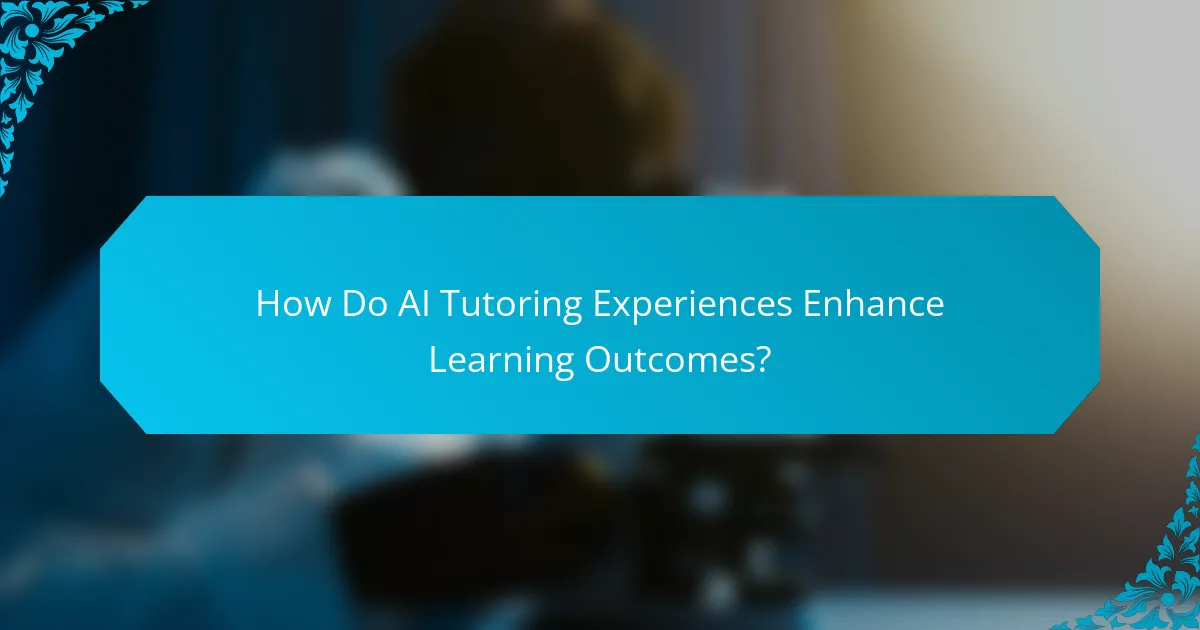
How Do AI Tutoring Experiences Enhance Learning Outcomes?
AI tutoring experiences significantly enhance learning outcomes by providing tailored educational support that meets individual student needs. These systems leverage advanced technologies to create personalized learning experiences, improve engagement, and track performance effectively.
Personalized learning paths
Personalized learning paths allow students to progress at their own pace, focusing on areas where they need the most improvement. AI systems analyze a learner’s strengths and weaknesses, adapting the curriculum accordingly to ensure mastery of concepts before advancing.
For example, a student struggling with algebra might receive additional resources and practice problems tailored specifically to that topic, while another student excelling in the same area can move on to more complex subjects. This customization fosters a more effective learning environment.
Real-time feedback mechanisms
Real-time feedback mechanisms provide immediate insights into a student’s performance, allowing for quick adjustments in learning strategies. AI tutoring systems can instantly assess answers and offer corrective suggestions, helping students understand mistakes as they occur.
This immediate feedback loop encourages active learning and helps students build confidence in their abilities. For instance, if a student answers a question incorrectly, the system can provide hints or explanations right away, facilitating a deeper understanding of the material.
Data-driven performance tracking
Data-driven performance tracking enables educators and students to monitor progress over time through analytics and reports. AI tutoring platforms collect data on various metrics, such as quiz scores, time spent on tasks, and engagement levels, providing a comprehensive view of a learner’s journey.
With this information, teachers can identify trends and make informed decisions about instructional strategies. For example, if a student consistently struggles with specific topics, targeted interventions can be implemented to address those gaps.
Adaptive learning technologies
Adaptive learning technologies adjust the difficulty and type of content presented to students based on their performance. These systems use algorithms to modify lessons in real-time, ensuring that learners are consistently challenged without becoming overwhelmed.
For instance, if a student demonstrates proficiency in basic math skills, the system may introduce more complex problems or related concepts, promoting continuous growth. This adaptability keeps students engaged and motivated to learn.
Engagement through gamification
Engagement through gamification incorporates game-like elements into the learning process, making education more enjoyable and interactive. AI tutoring platforms often use rewards, challenges, and leaderboards to motivate students and enhance their learning experience.
For example, students might earn points for completing assignments or achieving high scores on quizzes, which can be redeemed for virtual rewards. This approach not only increases participation but also fosters a sense of accomplishment and competition among peers.
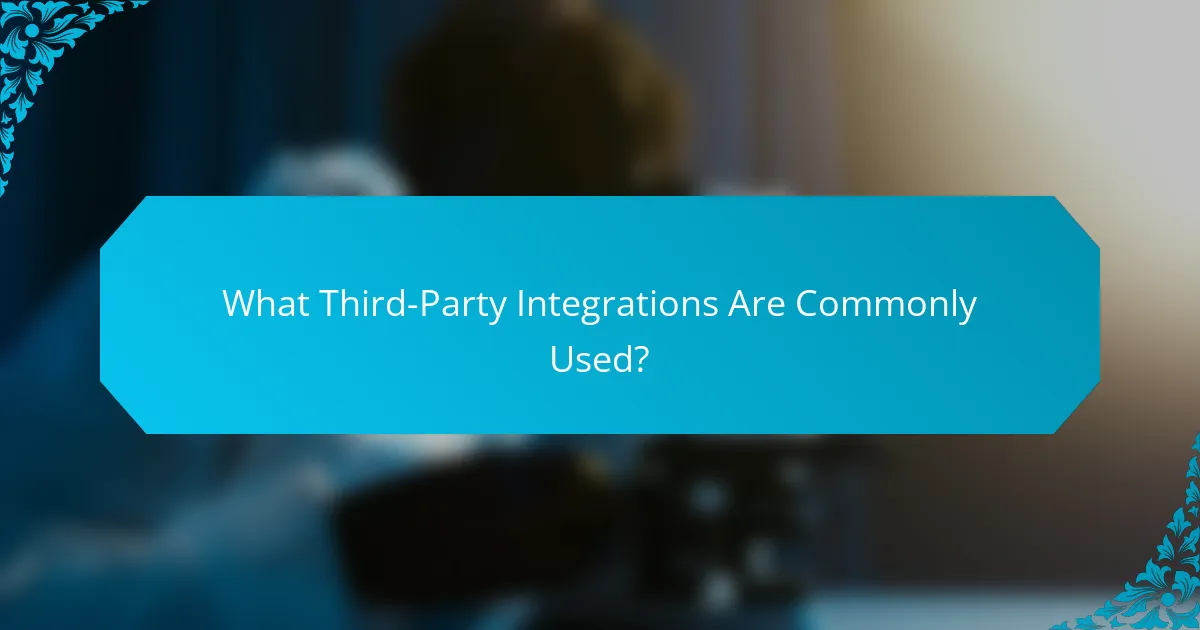
What Third-Party Integrations Are Commonly Used?
Common third-party integrations in AI tutoring enhance the learning experience by connecting various educational tools and platforms. These integrations streamline processes, improve engagement, and offer a more cohesive learning environment.
Learning Management Systems (LMS)
Learning Management Systems are essential for organizing and delivering educational content. They allow educators to manage courses, track student progress, and facilitate communication between students and instructors.
Popular LMS options include Moodle, Canvas, and Blackboard. When choosing an LMS, consider factors like user interface, integration capabilities, and support for multimedia content.
Video conferencing tools
Video conferencing tools enable real-time interaction between tutors and students, making remote learning more effective. They support live discussions, presentations, and collaborative activities.
Common platforms include Zoom, Microsoft Teams, and Google Meet. Ensure the chosen tool has features like screen sharing, breakout rooms, and recording options to enhance the tutoring experience.
Assessment platforms
Assessment platforms provide tools for creating, administering, and grading tests and quizzes. They help educators evaluate student performance and identify areas for improvement.
Examples include Quizlet, Kahoot!, and Google Forms. Look for platforms that offer analytics and feedback features to better understand student learning outcomes.
Content libraries
Content libraries offer a wealth of resources, including videos, articles, and interactive materials that can supplement tutoring sessions. They provide diverse learning materials that cater to different learning styles.
Popular content libraries include Khan Academy, Coursera, and EdX. When selecting a library, consider the relevance of the content to your curriculum and the ease of integration with other tools.
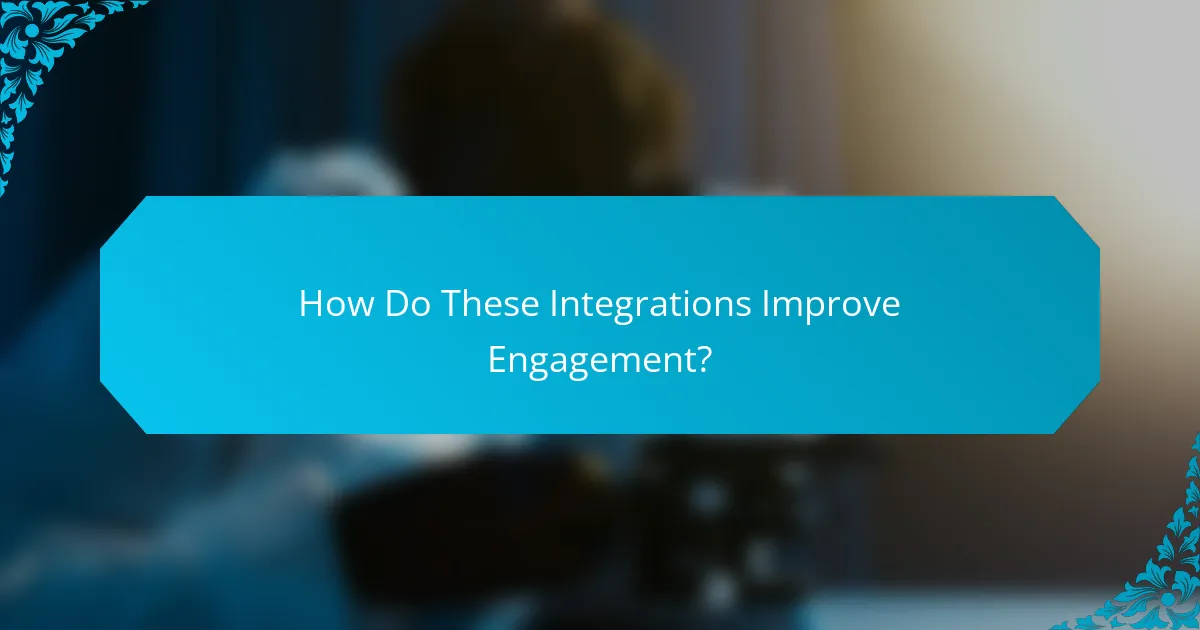
How Do These Integrations Improve Engagement?
Integrations with third-party tools significantly enhance engagement by creating a more interactive and personalized learning environment. These integrations streamline processes, foster collaboration, and provide access to a wider array of resources, making learning more effective and enjoyable.
Seamless user experience
A seamless user experience is crucial for maintaining student engagement. Integrations that allow for single sign-on or automatic data syncing reduce friction, enabling learners to focus on their studies rather than navigating multiple platforms. For instance, using a unified dashboard can help students track their progress without the hassle of switching between applications.
Consider tools that offer intuitive interfaces and minimal loading times, as these factors can significantly impact user satisfaction. A smooth experience encourages consistent usage, which is vital for effective learning outcomes.
Enhanced collaboration features
Enhanced collaboration features foster a sense of community among learners, which can lead to increased motivation and engagement. Tools that allow for real-time feedback, group projects, and discussion forums enable students to interact and learn from one another. For example, integrating platforms like Google Workspace can facilitate collaborative document editing and brainstorming sessions.
When selecting tools, ensure they support easy communication among peers and instructors. Features such as chat functions, video conferencing, and shared workspaces can create a more interactive learning environment.
Access to diverse resources
Access to diverse resources broadens the learning experience and keeps students engaged. Integrations that connect to libraries, databases, and educational content providers allow learners to explore various materials that cater to different learning styles. For instance, incorporating platforms like Khan Academy or Coursera can provide supplementary videos and exercises that enhance understanding.
When considering resource integrations, prioritize those that offer high-quality, relevant content. A wide range of resources can help address different topics and skill levels, making learning more adaptable and personalized for each student.
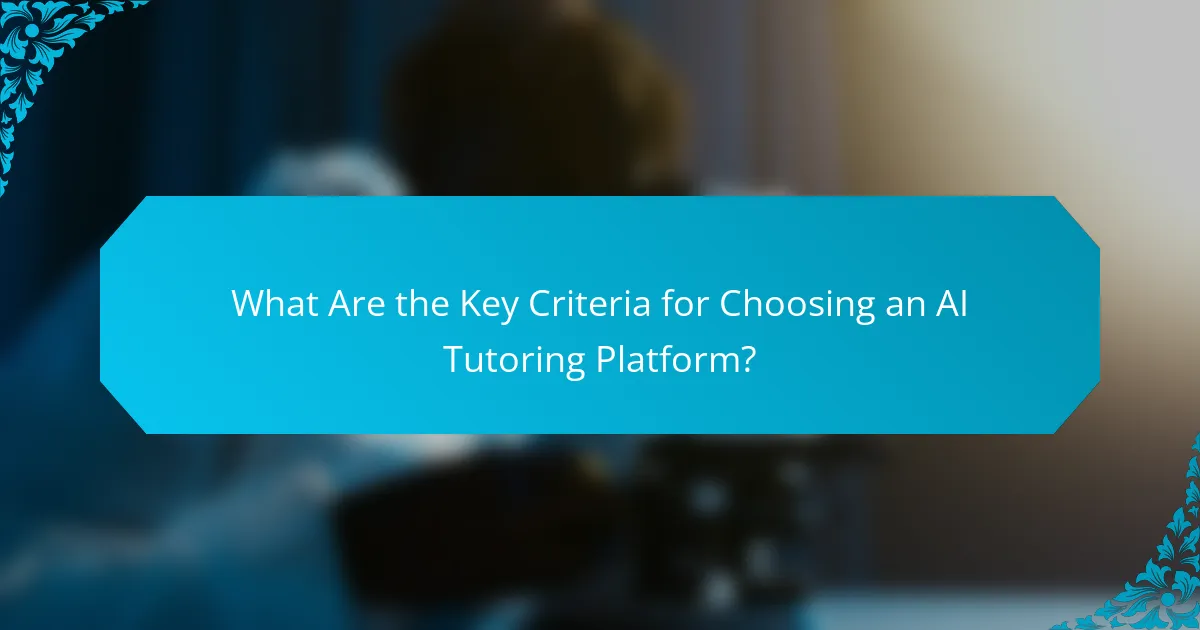
What Are the Key Criteria for Choosing an AI Tutoring Platform?
When selecting an AI tutoring platform, consider scalability, integration capabilities, and user support. These criteria ensure the platform meets the needs of diverse learners and can adapt to changing educational environments.
Scalability and flexibility
Scalability refers to the platform’s ability to accommodate a growing number of users without compromising performance. A flexible platform can adapt to various educational contexts, whether for individual tutoring or large classroom settings.
Look for platforms that can handle different learning styles and content types, allowing educators to customize lessons. For example, a solution that supports both synchronous and asynchronous learning can be beneficial for diverse student needs.
Integration capabilities
Integration capabilities determine how well the AI tutoring platform works with existing educational tools and systems. A platform that easily integrates with Learning Management Systems (LMS), gradebooks, and communication tools can streamline the teaching process.
Check for compatibility with popular platforms like Google Classroom or Microsoft Teams. This can enhance the user experience and facilitate smoother data transfer, which is crucial for tracking student progress and outcomes.
User support and training
User support and training are essential for maximizing the effectiveness of an AI tutoring platform. Consider platforms that offer comprehensive onboarding, tutorials, and ongoing assistance to help educators and students navigate the system.
Evaluate the availability of resources such as live chat, email support, or a dedicated help center. Effective support can significantly reduce frustration and ensure that users can fully leverage the platform’s features for improved learning outcomes.
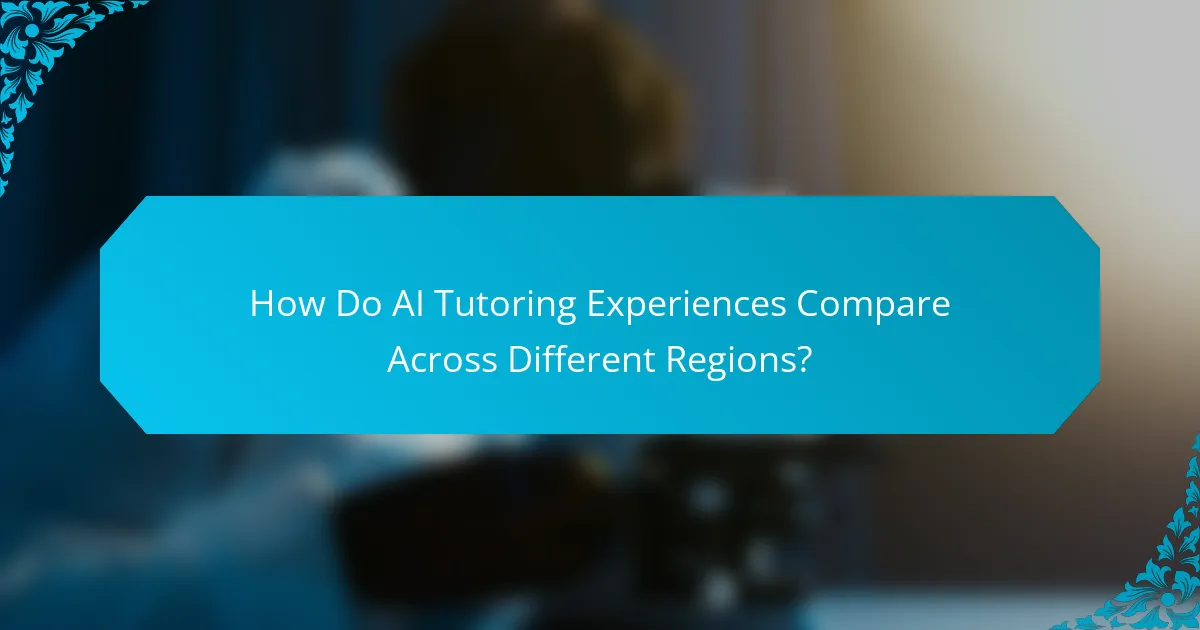
How Do AI Tutoring Experiences Compare Across Different Regions?
AI tutoring experiences vary significantly across regions due to differences in educational standards, cultural engagement strategies, and language support features. These factors influence how effectively AI can enhance learning outcomes and student engagement.
Regional educational standards
Educational standards differ widely from one region to another, affecting the integration of AI tutoring tools. For instance, countries in the European Union often adhere to strict guidelines that ensure quality and equity in education, while other regions may have more flexible standards. Understanding these differences is crucial for tailoring AI solutions to meet local requirements.
In regions with high educational standards, AI tutoring systems may need to align closely with curriculum benchmarks, ensuring that content is relevant and meets learning objectives. Conversely, in areas with less formalized standards, AI can introduce innovative teaching methods that may not be present in traditional education.
Cultural engagement strategies
Cultural context plays a significant role in how students interact with AI tutoring systems. In some regions, educational practices emphasize collaborative learning, which can be enhanced by AI tools that facilitate group activities. In contrast, cultures that prioritize individual achievement may benefit from AI systems that focus on personalized learning paths.
AI tutoring can also incorporate local customs and values, making the learning experience more relatable. For example, using culturally relevant examples and scenarios can increase student engagement and motivation, leading to better learning outcomes.
Language support features
Language support is essential for effective AI tutoring, especially in multilingual regions. AI systems that offer translation and localization features can cater to diverse student populations, ensuring that language barriers do not hinder learning. For instance, in countries with multiple official languages, AI tutors can switch between languages seamlessly to accommodate all learners.
Additionally, incorporating local dialects and colloquialisms can enhance comprehension and relatability. AI tutoring platforms should prioritize language support features that reflect the linguistic diversity of their target regions to maximize engagement and effectiveness.

What Are the Emerging Trends in AI Tutoring?
Emerging trends in AI tutoring focus on third-party integrations, enhanced engagement techniques, and improved learning outcomes. These advancements leverage technology to create personalized learning experiences that adapt to individual student needs.
Third-Party Integrations in AI Tutoring
Third-party integrations enhance AI tutoring platforms by connecting them with various educational tools and resources. This allows for a more comprehensive learning environment where students can access diverse materials, such as interactive simulations, video lectures, and assessment tools.
For example, integrating platforms like Google Classroom or Microsoft Teams can streamline communication and resource sharing. Educators should consider the compatibility of these tools with their existing systems to maximize efficiency and user experience.
Enhanced Engagement Techniques
Enhanced engagement techniques in AI tutoring include gamification, interactive content, and personalized feedback. These methods aim to keep students motivated and actively participating in their learning journey.
Incorporating elements like quizzes, badges, and leaderboards can make learning more enjoyable. Educators should focus on balancing challenge and support to maintain student interest without causing frustration.
Improving Learning Outcomes
Improving learning outcomes through AI tutoring involves using data analytics to track student progress and adapt instruction accordingly. AI systems can analyze performance patterns and suggest tailored interventions to address specific learning gaps.
For instance, if a student struggles with a particular concept, the AI can recommend additional resources or alternative explanations. Educators should regularly review these analytics to refine their teaching strategies and ensure all students achieve their potential.
